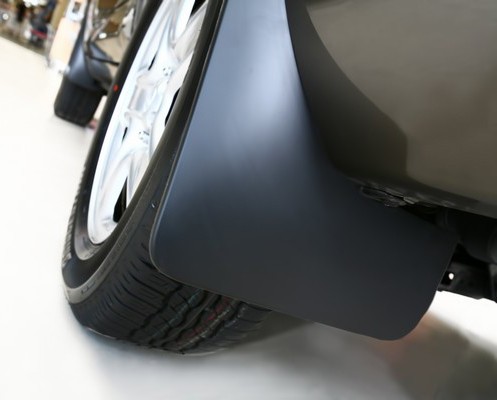
Mudguards – a practical accessory or an unnecessary element? Is it worth it to install car mudguards?
Content
Mudguards - where to use them?
The scope of mudguards is really wide. These rubber elements are an essential element of agricultural machinery equipment. Mudguards should be attached to semi-trailers, tractors and other vehicles in which the height above the roadway of the element located behind the wheel (mudguard) exceeds 25% of the distance between this element and the vertical plane passing through the rear of the steering wheel. In practice, the fact is that everything that rises behind the wheel stops on the mudguard or apron, and does not take off into the air.
The same applies to vehicles with a GVW of up to 3.5 tonnes. Cars, vans, trucks and buses must contain this type of additive. However, today in most cases it is not, at least in passenger cars. Why? A further part of the entry regarding the use of mudguards states that they do not apply to vehicles in which there is no place for them at the factory.
Should I add mudguards?
If your vehicle was not equipped with standard aprons, you do not need to use them. However, the operating conditions of vehicles in our country can make many drivers think about whether it is worth going in the direction of installing them. There are many models on the market adapted to a specific car, as well as universal or rally mudguards. They can be adapted to a motorcycle, SUV, delivery vehicle, farm vehicle, and even a trailer towed on a hook.
What to remember when choosing car mudguards?
When choosing mudguards, remember a few important rules:
- the apron should not be less than the width of the tire. If you want to change the size of wheels and tires throughout the season, think carefully about what kind of mudguards you will put on your car;
- Mudguards must be soft enough to effectively block water, mud and rocks that can be thrown back behind the car.
How to install mud flaps on semi-trailers and mud flaps on agricultural machinery?
There are several ways to attach mudguards. It all depends on the type of vehicle, the rigidity of the fender or bumper, and the type of material from which the apron is made. For example, in agricultural machinery and trailers, mud flaps are implemented in place of the factory mounting holes. Spare parts should also be selected so that they already have space for mounting brackets. Then it remains only to choose the right tire width and mudguard height.
The situation is somewhat different, for example, in the case of single-axle trailers that are towed on a hook in cars or delivery vehicles. They don't always have to be fitted with mudguards at the factory, so the driver can install them however they want. For this, a drill, a riveter or several screws with nuts and a metal strip corresponding to the width of the apron are useful. In this way, universal mudguards can be correctly installed without exposing them to rubber separation at the attachment points.
Universal mudguards for cars, is it a good choice?
In passenger cars, the situation is somewhat different. Universal mudguards may not be a good choice. It is often better to opt for special or thinner mudguards. Why? Due to the thin wing and wheel arch design.
Assemble the mudguards evenly so as not to pierce the body elements many times. An improperly installed mudguard can cause water and other contaminants to accumulate between it and the body and lead to corrosion.
Stiffness of rally mudguards, for semi-trailers and universal mudguards
Remember that the chosen mudguards: for a semi-trailer, rally or station wagon have the right rigidity. Why? Too soft rubber elements will not provide sufficient protection for vehicles moving behind from pebbles and other dirt. On the other hand, mudguards that are too rigid can lead to displacement of assembly elements and mechanical damage to the body. As a consequence, there may be serious defects and the need to repair the sheet metal.
To summarize: in some cases protective aprons are necessary. However, in most cases they are just an option. Be sure to choose the right one for your vehicle and the properties of the rubber. Also, do not forget about the solid assembly. Of these products, you should choose something that will not spoil, but will add additional value to the car.